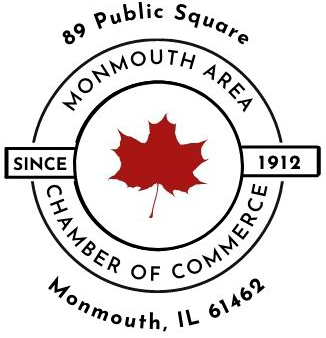Walk up the 10 concrete steps to Monmouth’s Pioneer Cemetery at East Archer and 6th Street, and suddenly you find yourself on a broad flat plateau littered with broken marble headstones — many of them weathered beyond readability and only a few still standing. Most have been there since before the current city cemetery was laid out. Yet here and there are a few pristine granite markers that seem strangely out of place.
Look closely and you may see dates of on the stones engraved years after the ancient cemetery accepted its last burial in 1858. What explains this strange anomaly?
The answer lies in the efforts of Hugh Robb Moffet, longtime editor and publisher of the Daily Review Atlas, who is perhaps best known for having written an “Old Timer” column for the paper in the decades prior to his 1957 death. A respected Warren County historian, Moffet in the 1930s became concerned not only about the deteriorating condition of the Pioneer Cemetery, but also about the increasing demise of small rural cemeteries that were being plowed under for farmland. His concern was so great that he took the controversial step of having headstones from abandoned rural cemeteries transferred to the Pioneer Cemetery, thus preserving them, despite the fact that there were no corresponding human remains transferred with them.
All of which is prologue to this week’s column, which is about a fascinating Warren County family represented in the Pioneer Cemetery — in stone but not in remains.
In almost the exact center of the cemetery stand two granite obelisks memorializing a mother and daughter who were actually buried in the long-gone Denny Cemetery in rural Sumner Township.
When she died at the age of 81 in 1892, the mother — Mary Osborn — was perhaps the oldest resident of Sumner Township, living on land just west of Little York that her first husband, James Moffit, had purchased in 1832.
Born in Ohio in 1810, Mary Moler had moved with her parents to Lafayette, Indiana in 1825, where she married Mr. Moffit three years later. In the fall of 1832, the couple and their two young children set off for Illinois with an ox-team, taking with them a wagon full of household goods and three cows. Arriving at the Illinois River, they moved into a vacant log house where they spent the winter before heading to their claim in Warren County.
Upon reaching their destination, James cut logs and built a primitive shelter, but that June he suddenly died, leaving Mary not only a widowed mother in the wilderness, but vulnerable to Indian attacks. The Black Hawk War had begun that April, and settlers Jonathan Ritchey and L. P. Rockwell had built a blockhouse on the hill above Cedar Creek, where terrified settlers including Mary Moffitt and her children took refuge.
On the morning of Aug. 9, a young farmer named William Martin disregarded warnings not to venture far from the stockade and was cutting grass for his horses in the fields below the fort. Mary and her sister watched as five renegade Sac Indians emerged from the woods and shot him before he could reach safety. They then surrounded him, shot him again and cut off his scalp.
Terrified, Mary took one of her children in her arms and fled into an adjoining cornfield. Her sister took the other child and followed. They then ran into a field of buckwheat, where they hid, hoping the children would remain silent. Fortunately, they did. Mary remained in the blockhouse for several weeks before moving back into her homestead, renting the land to farmers.
Two years later, Mary became the wife of John Claypool Osborn, a widower from North Carolina. He took over management of the farm, erected buildings and greatly increased its value. The couple meanwhile had six children, but sadly Mary’s children from her first marriage died young. One of them — Nancy — married a farmer named Hiram Pense in Henderson County and had four children, but Nancy died of a fever in 1860 at the age of 30. It is her headstone that stands next to Mary’s in Pioneer Cemetery.
Heartache would strike Mary and her second husband in 1863, when their son John, who had enlisted as a private in Company F of the 83rd Illinois Infantry, died at Fort Donelson in Tennessee. Mary’s husband himself died in 1874, but by then the farm was in the capable hands of their one remaining son, George P. Osborn, who is perhaps the single most intriguing character in this story.
Osborn, who in 1892 commissioned the headstones for his mother and his half-sister Nancy, was considered an eccentric. Although a successful farmer of 240 acres, he could neither read nor write. Littering his house and yard were hundreds of curios, including relics of Indian days.
Shortly before his death in 1902, Osborn called the two men he had named as executors to his estate and told them of a valuable box he had hidden in an upstairs room. They followed as he feebly dragged himself upstairs, where he removed a clothes rack from the wall and opened a mysterious panel behind it that hid a closet. He told the men to enter the closet and remove a box of money from an old trunk.
Inserting a key into the box the men were startled to find it full of gold coins worth $8,400 (approximately $275,000 in today’s money). Osborn explained that years earlier he had secured a patent on a butter churn, receiving a royalty of $20,000, of which the gold was what remained. Another box of rare old coins was also found in the trunk.
In the cellar of the house were found several barrels of grape wine of Osborn’s own vintage. A few years earlier, he had been arrested by federal agents who found a whiskey still on the property, but after proving that he had never lit a fire under it he was released from jail with a $300 fine.
Osborn, who had been divorced by his wife two years before, left his entire estate to his two young children, ages 9 and 11.

by Jeff Rankin
Editor and historian for Monmouth College. Avid researcher of western Illinois history for 40 years. FB and Twitter. jrankin@monmouthcollege.edu



